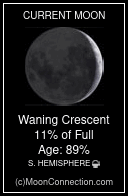| Earth |
3rd planet. Appears to be infested with humans. |
| Eccentricity |
The measure of how an object's orbit differs from a perfect circle. Eccentricity defines the shape of an object's orbit. |
| Eclipse |
The total or partial blocking of one celestial body by another. |
| Eclipsing Binary |
A binary system where one object passes in front of the other, cutting off some or all of its light. |
| Ecliptic |
An imaginary line in the sky traced by the Sun as it moves in its yearly path through the sky. |
| Ejecta |
Material from beneath the surface of a body such as a moon or planet that is ejected by an impact such as a meteor and distributed around the surface. Ejecta usually appear as a lighter color than the surrounding surface. |
| Electromagnetic Radiation |
Another term for light. Light waves created by fluctuations of electric and magnetic fields in space. |
| Electromagnetic Spectrum |
The full range of frequencies, from radio waves to gamma waves, that characterizes light. |
| Ellipse |
An ellipse is an oval shape. Johannes Kepler discovered that the orbits of the planets were elliptical in shape rather than circular. |
| Elliptical Galaxy |
A galaxy whose structure shaped like an ellipse and is smooth and lacks complex structures such as spiral arms. |
| Elongation |
The angular distance of a planetary body from the Sun as seen from Earth. A planet at greatest eastern elongation is seen in the evening sky and a planet at greatest western elongation will be seen in the morning sky. |
| Ephemeris |
A table of data arranged by date. Ephemeris tables are typically to list the positions of the Sun, Moon, planets and other solar system objects. |
| Epoch |
A date chosen as a reference point for observation. (Currently 2000 epoch) |
| Equatorial mount |
|
| Equinox |
The two points at which the Sun crosses the celestial equator in its yearly path in the sky. The equinoxes occur on or near March 21 and September 22. The equinoxes signal the start of the Spring and Autumn seasons. |
| Escape Velocity |
The speed required for an object to escape the gravitational pull of a planet or other body. |
| Escape velocity from Earth |
11.2 km/s; Mach 34. |
| Event Horizon |
The invisible boundary around a black hole past which nothing can escape the gravitational pull - not even light. |
| Evolved Star |
A star that is near the end of its life cycle where most of its fuel has been used up. At this point the star begins to loose mass in the form of stellar wind. |
| Extinction |
The apparent dimming of star or planet when low on the horizon due to absorption by the Earth's atmosphere. |
| Extragalactic |
A term that means outside of or beyond our own galaxy. |
| Extraterrestrial |
A term used to describe anything that does not originate on Earth. |
| Eyepiece |
The lens at the viewing end of a telescope. The eyepiece is responsible for enlarging the image captured by the instrument. Eyepieces are available in different powers, yielding differing amounts of magnification. |

